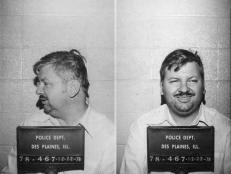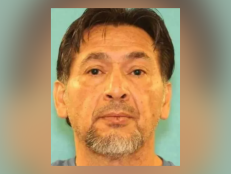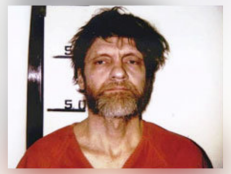The Chilling Case Of Dean Corll, The Suspected Serial Killer Known As 'The Candy Man'
Authorities believe Corll raped, tortured, and killed at least 28 young men in the 1970s. His alleged reign of terror ended when a teenager turned on him — with a gun.
![San Augustine County Sheriff deputies Robert McCroskey and Charles Martin display torture implements found inside and under a cabin owned by the parents of Dean Corll [AP Photo]](http://investigationdiscovery.sndimg.com/content/dam/images/investigationdiscovery/crimefeed/legacy/2019/09/AP-Dean-Corll-Torture-Board--7308150155.jpg.rend.hgtvcom.616.462.suffix/1568840970790.jpeg)
San Augustine County Sheriff deputies Robert McCroskey and Charles Martin display torture implements found inside and under a cabin owned by the parents of Dean Corll [AP Photo]
Between 1970 and 1973, Dean Corll allegedly raped, tortured, and killed at least 28 young men in the Houston area. The allegations surfaced after one of Corll’s two convicted accomplices confessed to killing Corll, police said.
Corll was reportedly dubbed "Candy Man" by locals because his family owned a candy factory, and he was known for handing out free samples to kids.
In 1964, Corll, then 24, was drafted into the U.S. Army. He was reportedly unhappy in the service and was discharged 10 months later. Upon returning home, Corll reportedly befriended 12-year-old David Owen Brooks.
Brooks later alleged Corll committed "oral sodomy on him," according to a police officer quoted in a 1975 UPI article. It's alleged Corll coerced the boy to join him in an array of atrocities over the next three years.
Investigators suspect Corll began killing on September 25, 1970, when Jeffrey Konen, an 18-year-old college student and hitchhiker, was strangled to death. After that, authorities believe Corll hatched a horrifically successful plan to find more victims.
Investigators say Brooks would hit the streets in search of teenage boys to lure back to Corll. Once inside, they would allegedly drink and get high until, sometimes, victims would find themselves strapped to a "torture board," police said. Corll then allegedly raped and brutalized the victims, sometimes for days at a time.
The victim's torment allegedly only ended with Corll choking them to death or fatally shooting them with a .22-caliber pistol, police said. Then, authorities claim, Brooks helped Corll bury bodies on local beaches or other waterfront areas.
In 1971, Corll and Brooks allegedly coerced the involvement of another young accomplice. Brooks allegedly lured Elmer Wayne Henley, 15, to Corll's house as a potential victim, but the Candy Man purportedly noticed the teen’s strapping physique and came up with a different idea.
Henley later reportedly claimed Corll told him he had connections to a Dallas-run "white slavery ring,” and the group was looking for recruiters. Corll reportedly offered Henley $200 for any teenage boys he could entice into partying with him, according to police.
Henley reportedly took to his new gig with enthusiasm, eventually participating in the actual murders.
"The Houston Mass Murders," as Corll's alleged crimes came to be called in the media, reportedly carried on unabated until August 8, 1973 — five days after the slaying of 13-year-old James Dreymala. It ended after Henley allegedly brought two potential victims to the Candy Man's place, and one of them was female.
Henley allegedly told police he had picked up Timothy Kerley, 19, and, en route to Corll's house, came across Rhonda Williams, 15. Henley invited Williams to come along and party, police said.
Corll reportedly went berserk about the presence of a girl in his home and allegedly raged at Henley he'd ruined the evening.
Despite his alleged anger, Corll, Henley told the police, loaded up the three youths with alcohol and weed until they passed out. When the teenagers awoke, they were bound, gagged and face down on the floor, Henley alleged.
Henley said he talked his way out of the bindings by promising to help Corll torture and kill the two teens tied up next to him, according to police.
Once freed, Henley said Corll ordered him to rape Williams while he violated Kerley. Instead, Henley claimed, he grabbed Corll's gun and opened fire, killing the so-called Candy Man.
The following day, according to The Houston Chronicle, Henley led police to a boat shed in southwest Houston, where authorities reportedly dug up the bodies of 17 young men. The victims allegedly ranged in age from 12 to 17.
The Chronicle reported Henley called his mother during the exhumation and journalists heard him say, “Momma, I killed Dean” and “Momma, be happy for me, because at least I can live now.”
Even in death, the case has kept investigators working. Police say they have identified 27 of the 28 alleged victims to date, but the search continues to locate other possible bodies and for more information.
![Unidentified photo found in Elmer Wayne Henley's possession [Harris County Institute of Forensic Sciences]](http://investigationdiscovery.sndimg.com/content/dam/images/investigationdiscovery/crimefeed/legacy/2019/09/Harris-County-Institute-of-Forensic-Sciences-unidentified-photo-found-in-elmer-wayne-henleys-possession-S9192019.jpg.rend.hgtvcom.616.347.suffix/1568740551346.jpeg)
Unidentified photo found in Elmer Wayne Henley's possession [Harris County Institute of Forensic Sciences]
In January 2018, a Polaroid surfaced that authorities said could depict a 29th victim. The photograph reportedly shows a young boy, possibly handcuffed, in what appears to be the trunk of a car.
ABC News reported that filmmaker Josh Vargas said he discovered the photo while doing research for a movie and looking through Henley’s belongings.
“While rummaging through those pictures,” Vargas said, “this Polaroid falls out. I take a look at it and, right off the bat, having studied the case and the crime scene photos and everything, I see Dean’s toolbox, and I see his implements in that toolbox, and I see this kid right here with handcuffs on his arms.”
Authorities reportedly showed the photo to Henley, who said while he didn’t remember that specific boy, he believes other victims remain undiscovered. The search for answers continues.
David Brooks was eventually convicted of one murder and sentenced to life behind bars. Wayne Elmer Henley was convicted of six murders and received six consecutive 99-year terms. Authorities did not pursue charges in the killing of Corll, as law enforcement determined he acted in self-defense.
Watch the “Candy Man” episode of Investigation Discovery’s “Blood, Lies & Alibis” on ID GO now!







![In 1995, Larry Hall [inset] was found guilty of kidnapping 15-year-old Jessica Roach [main] in 1993.](http://investigationdiscovery.sndimg.com/content/dam/images/investigationdiscovery/crimefeed/legacy/2022/06/jessica-roach-memorial-jessica-roach-grant-county-sheriffs-department-larry-hall-06232022.png.rend.hgtvcom.231.174.suffix/1656017153958.png)

